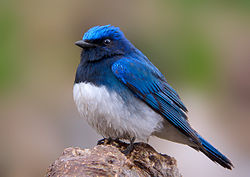Description
The Blue-and-White Flycatcher is a large (16–17 cm long, weigh 25 g on average) and strikingly beautiful flycatcher. The male is deep cobalt blue, with black on the face down to the upper part of the breast and flanks, the rest of the underside white. White is also visible on the base of the outer tail feathers. Immature male has the adult's blue wings but is brown otherwise. [6]
The female is smaller on average than the male, [7] with head, face and most of upperparts grey-brown, and pale beige-white on the lower part of the middle of the throat, young males are very similar. The female has a smaller-headed profile than other brown flycatchers in range. [8]
The song is a short, melancholic sounding series of whistles. [8]
Ecology
Habitat
Blue-and-white flycatchers breed in primary and secondary lowland and submontane forests (including taiga, wooded slopes, and gullies) up to 1200m, and also in riverine thickets and plantations. Outside the breeding season, it utilizes coastal woodland, scrub, parks, and gardens, and in Borneo winters at elevations up to 1850m [9] in forested hills, lower montane forest, plantations, and logged lowland forest. [10]
These flycatchers are most active in the morning. [11]
Breeding
The breeding season extends from late May to early August. The nests, constructed primarily of moss, are typically situated in a variety of sheltered locations, including crevices in cliffs, among tree roots, under overhanging stream banks, in shallow tree hollows, and, rarely, within abandoned buildings. The clutch size ranges from four to six eggs, which are incubated solely by the female for a period of 14 to 15 days. [10] Females spend more time and energy caring for young than males. [12] Nest parasites include the northern hawk-cuckoo, common cuckoo and lesser cuckoo. [13]
Diet
It feeds mainly on insects and larvae, but also eats berries, [14] including pokeweed. [15]
This page is based on this
Wikipedia article Text is available under the
CC BY-SA 4.0 license; additional terms may apply.
Images, videos and audio are available under their respective licenses.








